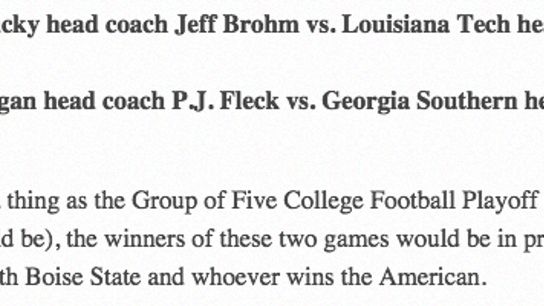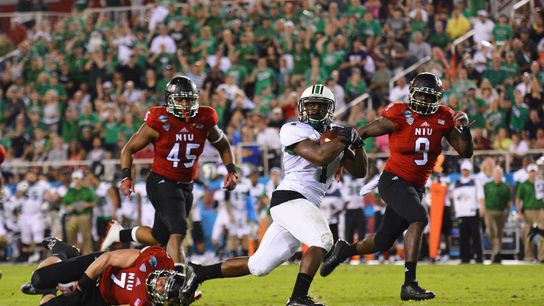Hidden within yesterday's article examining the top coaching matchups of the weekend was a kernel of an idea that deserves to be examined further:

Like a self-mowing lawn, a Group of Five playoff is something that makes you scratch your head and wonder, "Wait, why doesn't this exist?" Let's break this idea down Q&A style.
Q: There's already a College Football Playoff. Can you really just stage another one?
A: Yes, there is and, tellingly, the original college football playoff named itself simply the College Football Playoff. In its desire to keep itself and the conferences that founded it out of antitrust lawsuits, the playoff simply declares itself a playoff involving college football teams, and nothing more.
The CFP is a series of contracts between its member conferences (the ACC, Big Ten, Big 12, Pac-12 and SEC), the six participating bowl games (Cotton, Fiesta, Sugar, Orange, Peach and Rose) and its TV partner (ESPN). College football's postseason is loosely regulated by the NCAA; get two participating conferences and a stadium and the powers that be are likely to rubber stamp you on their way out to lunch. There's nothing stopping the Group of Five - American, Conference USA, MAC, Mountain West and Sun Belt - from copying their more well-fed brothers.
Q: Wait, aren't the Group of Five part of the Playoff?
A: Yes. The Group of Five has one reserved spot in a non-semifinal bowl each season. (Boise State defeated Arizona in the Fiesta Bowl last year.) And, honestly, the stickiest wicket in this whole idea is getting the money right (payouts last year ranged from $23.5 million to the Mountain West to $12 million for the Sun Belt) and convincing a, for example, No. 12 Boise State team it's better off playing an unranked Northern Illinois team than facing a No. 9 Florida State team in the Peach Bowl.
Q: So why would they do that?
A: Because a Group of Five team is never going to win a national championship as the system is currently constituted. And because college football is supposed to be fun and what's more fun than sticking it to the man?
Q: Okay, you've convinced me. So how would this work?
A: The CFP has a rotation of six bowls, where two host semifinals and the other four are glorified exhibitions, because hosting the ACC and SEC's second and third best teams is still a big enough draw to attract the requisite eyeballs to make the numbers work. That isn't the case here. To make things simple, let's contract two bowls with mid-sized stadiums in markets that would be happy to host a mid-major semifinal every year and call it a day. How about.... the Liberty Bowl in Memphis and the Las Vegas Bowl? There, that was easy.
Q: And what about the championship game?
A: The CFP championship is bid out like the Super Bowl because the CFP does not have to worry about filling a stadium, despite the fact that its participating teams are probably playing their third neutral site game in six weeks. We wouldn't have that luxury here. Sure, you could bid out the game, but to differentiate ourselves let's play the championship at the home stadium of the highest-ranked team.
Q: Who's picking these teams?
A: We'll stack the committee with coaches and media members that have a history of coaching and covering the mid-majors. And as an added bonus, we'll do our best to put the median age of committee members under 55.
Q: When would you play the games?
A: I'd capitalize on the public's desire for football and the relative lack of alternative options and play the semifinals before Christmas - right around Dec. 22 feels right - and play the championship game at the most opportune time between New Year's Day and the CFP championship.
Q: Who would you get to televise it?
A: ESPN feels like the obvious choice here considering they just about own the sport these days, but perhaps you could capitalize on Fox's desperation for relevance and draw a nice, fat check.
Q: Who would watch this thing?
A: You and everyone else you've ever met. It's football on television. And even better than that - it's football on television when it's really cold outside. This is easier than selling cheeseburgers to the famished.
Q: How would this work in real life?
A: Let's assume the playoff existed for last season. Boise State grabs the No. 1 seed and as a result locks in the Sun Bowl. By virtue of being one play away from an undefeated season, Marshall grabs the No. 2 seed and heads to Memphis. Sun Belt champion Georgia Southern was strangely ineligible for the postseason and, thus, is removed from consideration. Memphis claims the AAC bid and gains the rare advantage of a postseason home game, and Northern Illinois snares the final bid and faces Boise State in the Sun Bowl.
Q: Okay, you've sold me. Now what do we call this thing?
A: That's the only unanswered question. College Football Playoff 2.0? Mid-Major Madness? The NIFT?
Sure, we're not the first to think of this idea. And we're not television programmers or conference commissioners. But what we lack in originality or expertise, we make up for in our fervent belief this should exist.
